Files
Last update 7 years 10 months
by Gustav Pettersson
| FilesBuilding and CalibratingSPSTeensy | |
|---|---|
| .. | |
| SPSTeensy.ino |
SPSTeensy.ino// Copyright 2018 Gustav Pettersson, gustavpettersson@live.com // // This program is free software: you can redistribute it and/or modify // it under the terms of the GNU General Public License as published by // the Free Software Foundation, either version 3 of the License, or // (at your option) any later version. // // This program is distributed in the hope that it will be useful, // but WITHOUT ANY WARRANTY; without even the implied warranty of // MERCHANTABILITY or FITNESS FOR A PARTICULAR PURPOSE. See the // GNU General Public License for more details. // // You should have received a copy of the GNU General Public License // along with this program. If not, see <http://www.gnu.org/licenses/>. #include <ADC.h> //https://github.com/pedvide/ADC #include <EEPROM.h> //https://www.arduino.cc/en/Reference/EEPROM #include <LiquidCrystal.h> //https://www.arduino.cc/en/Reference/LiquidCrystal int DeviceID = EEPROM.read(0); //Keep unique ID in first index of EEPROM //Lookup tables used to set the IV curve uint16_t LookupA[4096] = {0}; uint16_t LookupB[4096] = {0}; //Start with active pointer on LookupA uint16_t* activeLookup = &LookupA[0]; uint16_t* inactiveLookup = &LookupB[0]; uint16_t DACvalue = 0; uint16_t ADCvoltvalue = 0; uint16_t ADCcurrvalue = 0; uint16_t newValue = 0; bool byteValid = true; bool arrayValid = true; bool LEDActive = false; bool printValues = false; elapsedMillis sincePrint; const int ADCvolt = A3; const int ADCcurr = A4; ADC *adc = new ADC(); const int DACPin = A14; IntervalTimer samplingTimer; IntervalTimer displayTimer; LiquidCrystal lcd(0, 1, 2, 3, 4, 5, 6, 7, 8, 11); void setup() { Serial2.begin(115200); Serial2.setTimeout(10); //String read timeout 10 ms pinMode(LED_BUILTIN,OUTPUT); analogWriteResolution(12); analogReference(INTERNAL); //INTERNAL is 1.195V 0.5%. EXTERNAL is 3.3V. pinMode(ADCvolt,INPUT); pinMode(ADCcurr,INPUT); //adc->analogRead(ADCvolt,ADC_1); //adc->analogRead(ADCcurr,ADC_0); adc->setResolution(12,ADC_0); adc->setAveraging(16,ADC_0); adc->setSamplingSpeed(ADC_SAMPLING_SPEED::LOW_SPEED,ADC_0); adc->setReference(ADC_REFERENCE::REF_1V2,ADC_0); adc->setResolution(12,ADC_1); adc->setAveraging(16,ADC_1); adc->setSamplingSpeed(ADC_SAMPLING_SPEED::LOW_SPEED,ADC_1); adc->setReference(ADC_REFERENCE::REF_1V2,ADC_1); pinMode(DACPin,OUTPUT); analogWrite(DACPin, 0); lcd.begin(8,2); lcd.write("U= 0.00V"); lcd.setCursor(0,1); lcd.write("I=0.000A"); samplingTimer.priority(128); samplingTimer.begin(update, 1000); //Update every 1 ms displayTimer.priority(255); displayTimer.begin(writeLCD, 500000); //Update every 500 ms } void writeLCD() { char voltage[5]; sprintf(voltage, "%*.2f", 5, ADCvoltvalue/186.2); char current[5]; sprintf(current, "%*.3f", 5, ADCcurrvalue/1881.3); lcd.setCursor(2,0); lcd.write(voltage); lcd.setCursor(2,1); lcd.write(current); } void update() { ADCvoltvalue = adc->analogRead(ADCvolt,ADC_1); ADCcurrvalue = adc->analogRead(ADCcurr,ADC_0); //Check that first four bits are zero (i.e. we have 12 bit number in the 16 bit uint) if ( !(ADCvoltvalue & 0xF000) ) { DACvalue = *(activeLookup+ADCvoltvalue); analogWrite(DACPin, DACvalue); if (printValues && sincePrint>100) { sincePrint = 0; char voltage[5]; sprintf(voltage, "%*.2f", 5, ADCvoltvalue/186.2); char current[5]; sprintf(current, "%*.3f", 5, ADCcurrvalue/1881.3); Serial2.print("ADC volt: "); Serial2.print(voltage); Serial2.print(" ADC curr: "); Serial2.print(current); Serial2.print(" DAC: "); Serial2.print(DACvalue); Serial2.print(" ADC: "); Serial2.println(ADCvoltvalue); } } } void loop() { if (Serial2.available() > 0) { String task = Serial2.readString(); if (task.substring(0,1).equals("W")) { //Who Serial2.print("SPS\n"); } else if (task.substring(0,1).equals("V")) { //Verison Serial2.print("1\n"); } else if (task.substring(0,1).equals("P")) { //Print values printValues = true; } else if (task.substring(0,1).equals("H")) { //Stop printing printValues = false; } else if (task.substring(0,1).equals("T")) { //Dump tables for (int i=0; i<4096; i+=256) { Serial2.println(*(activeLookup+i)); Serial2.println(*(inactiveLookup+i)); } } else if (task.substring(0,1).equals("I")) { //Get ID Serial2.print(DeviceID); Serial2.print("\n"); } else if (task.substring(0,1).equals("S")) { //Set ID int setID = task.substring(1).toInt(); if (setID > 0 && setID < 256) { EEPROM.write(0,setID); DeviceID = setID; Serial2.println("ID set!"); } } else if (task.substring(0,1).equals("D")) { //Set lookup table // This is where the fun begins, we are getting data! LEDActive = true; digitalWrite(LED_BUILTIN,HIGH); Serial2.print("OK\n"); //Acknowledge we are ready for the transfer arrayValid = true; //Wait for the buffer to fill with the data unsigned long startTime = millis(); while(Serial2.available() < 8192) { if ( (millis() - startTime)>5000 ) { arrayValid = false; break; } } if (arrayValid) { for (int i=0; i<4096; i++) { //Clear variable newValue = 0; byteValid = true; //Read MSBs and insert uint8_t msb = Serial2.read(); if ( !(msb>>6 ^ B10) ) { //Check identifier msb = msb & B00111111; //Remove identifier } else {byteValid = false;} //Read LSBs and insert uint8_t lsb = Serial2.read(); if ( !(lsb>>6 ^ B01) ) { //Check identifier lsb = lsb & B00111111; //Remove identifier } else {byteValid = false;} if (byteValid) { *(inactiveLookup + i) = msb<<6 | lsb; //Put new value in inactive array } else { Serial2.println("Read Error"); arrayValid = false; break; } } } //Switch the active/inactive pointers if all went as planned if (arrayValid) { noInterrupts(); uint16_t* temp = activeLookup; activeLookup = inactiveLookup; inactiveLookup = temp; interrupts(); Serial2.print("F\n"); //Acknowledge we are done with the transfer } else { Serial2.println("Read Error at End"); //Something failed } } } else { //Keep LED at 50% duty cycle with unused CPU time if (LEDActive) { LEDActive = false; digitalWrite(LED_BUILTIN,LOW); } else { LEDActive = true; digitalWrite(LED_BUILTIN,HIGH); } } }








